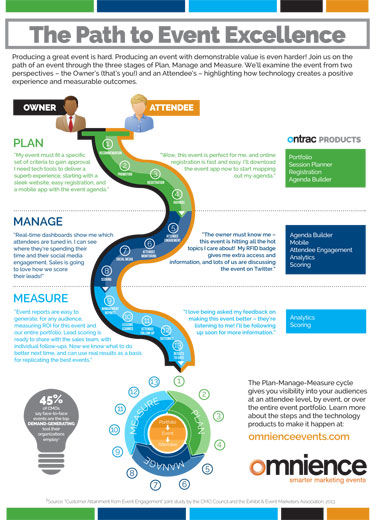Defend your spend - with event analytics
At many companies, budgets for marketing events - along with print and broadcast media - are being cut this year. According to a survey by Aquent/American Marketing Association, 14% of marketers expect to decrease their organization’s focus on the “events/trade shows/virtual events” category in 2013.
That doesn’t surprise me at all. I can almost hear what CEOs and CFOs are saying to their marketing colleagues: “You can’t tell me how many prospects you got last year. You can’t tell me what their post-event revenue potential is. You can’t tell me what sales, if any, are attributable to last year’s event. And now you’re asking for a budget INCREASE? Well, you can …” (Sorry, the rest of the diatribe is not suitable for this blog.)
Clearly, in these times, any sizeable line item in any function’s budget is going to get close scrutiny from top management. Marketers have to justify all expense categories, with no exemption for any virtual or on-location event. In your company, that may mean gathering information you’ve never gathered before—so you can measure what you’ve never measured before.
Here’s a “Cliff Notes” version of how some Omnience customers are demonstrating the value of their events portfolio:
- Event approval: To enter the planning cycle, an event must meet specific criteria—including estimates of potential revenue from the event.
- Planning: Professional resources, internal or external, are allocated to handle the myriad details that go into planning and executing an event, including site selection, facility negotiations, agenda planning, and managing reservations. Flawless performance of these activities is essential for making the event cost effective and giving attendees a superb experience.
- Promotion: Sales and Marketing work closely to segment target audiences and generate interest in the event. Both functions know in advance who has registered and who has not, so they can focus resources on getting the right people at the event.
- Sales intelligence and lead management: Processes are in place to capture feedback from attendees — during and after the event-and gauge their value as prospects for specific products. Immediately after the event, the sales force can prioritize its follow-up activities with scored, qualified leads.
- Event analytics: Before, during and after the event, the CMO has a rich set of real-time, graphical reports to analyze actual vs. budgeted costs as well as revenue projections.
- Sales tracking: Subsequent sales are automatically linked back to attendees of specific events. This closes the loop between an event and the contracts resulting from the event-and gives management the ROI information they need to see the event’s value.
- Portfolio management: With rich data available on every event, management can see which events are working and which are not working.
By using one technology for the entire event planning, promotion, management, and reporting cycle, event managers and the C-suite can gain 360-degree insights into the value of every marketing event.




